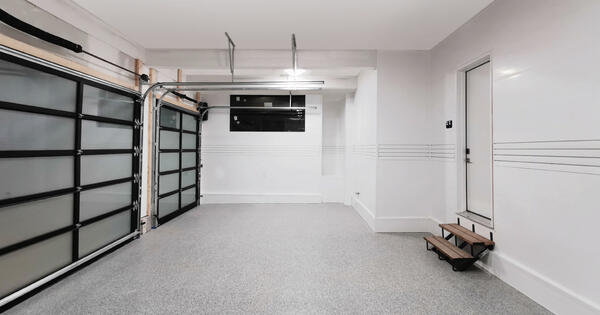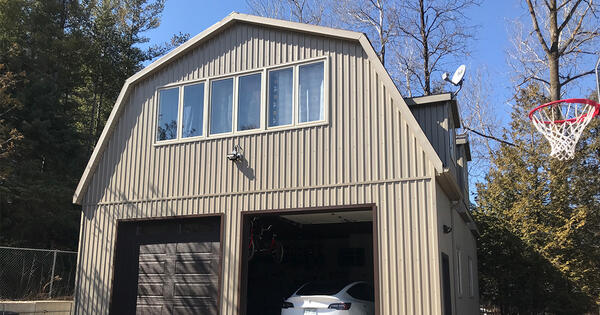Maintaining proper humidity levels in your garage might not be the first thing on your mind when it comes to home maintenance, but it's crucial for a variety of reasons.
High humidity can lead to a host of problems, from mold growth to rusting tools and unpleasant odors. In this blog post, we'll delve into the importance of dehumidifying your garage and provide practical solutions to keep it dry and comfortable year-round.



Understanding Humidity
Humidity refers to the amount of moisture present in the air. It's a crucial factor in determining the comfort and health of indoor spaces, including your garage. When humidity levels are too high, it can create a damp, muggy environment that's not only uncomfortable but also conducive to the growth of mold, mildew, and other moisture-related issues.
Ideal humidity levels for a garage typically fall between 30% and 50%. This range strikes a balance between preventing excessive moisture buildup and avoiding overly dry conditions.
Now, what happens if humidity levels creep up in your garage? The consequences can lead to costly repairs and more:
- High humidity encourages the growth of mold and mildew which give off musty odors and can damage your belongings stored in the garage, such as clothing, furniture, and even tools.
- Excessive moisture can lead to corrosion of metal surfaces, including tools and machinery, which could potentially shorten their lifespan and compromise their functionality.
- High humidity can also cause wood to swell and warp, affecting any wooden furniture or structures you may have in the garage.
- High humidity can also impact your health by creating a favorable environment for dust mites and other allergens, potentially triggering respiratory issues or allergies.
So, maintaining optimal humidity levels in your garage isn't just about comfort – it's also about protecting your belongings and your health.
Causes of High Humidity in Garages
Several factors can contribute to high humidity levels in a garage. Let's break down some common culprits and the solutions to address each of them:
- Poor Ventilation: One of the main reasons for high humidity in a garage is poor ventilation. When air circulation is limited, moisture tends to accumulate, especially in enclosed spaces. Improving ventilation is key. Install vents or exhaust fans to allow stale, humid air to escape and fresh air to circulate into the garage. Opening windows and doors periodically can also help facilitate air exchange.
- Lack of Insulation: Garages that are poorly insulated are prone to temperature fluctuations, which can lead to condensation buildup and increased humidity levels. Insulate the walls, ceiling, and doors of your garage to regulate temperature and prevent moisture from entering. Use insulation materials such as foam boards, fiberglass, or spray foam to create a barrier against external moisture.
- Water Intrusion: Water leaks from rain, melting snow, or plumbing issues can introduce excess moisture into the garage, elevating humidity levels. Identify and fix any sources of water intrusion promptly. Repair damaged roof shingles, seal gaps around doors and windows, and address plumbing leaks. Installing gutters and downspouts to direct rainwater away from the garage can also help prevent water seepage.
- Wet Items and Activities: Wet items like damp clothes, wet shoes, or even water-based activities such as washing cars or storing wet sports equipment can introduce moisture into the garage. Ensure that wet items are dried thoroughly before storing them in the garage. Consider using a separate drying area or rack for wet clothes and gear. If washing cars inside the garage, ensure proper ventilation and allow sufficient time for the area to dry out afterward.
- Ambient Weather Conditions: External weather conditions, such as high humidity levels or heavy rainfall, can impact the moisture content inside the garage. While you can't control the weather, you can take proactive measures to mitigate its effects. Monitor weather forecasts and take preemptive steps to manage humidity levels, such as using dehumidifiers during periods of high humidity or sealing gaps during heavy rainfall to prevent water intrusion.
By addressing these common factors contributing to high humidity levels, you can effectively reduce moisture buildup in your garage and create a more comfortable and healthier environment.
Benefits of Dehumidification
Installing a dehumidifier in your garage can help you maintain a comfortable and functional space in several ways:
- Mold and Mildew Prevention: By reducing excess moisture in the air, a dehumidifier helps inhibit the growth of mold and mildew, which thrive in damp environments. This not only prevents unsightly mold stains and musty odors but also helps safeguard your belongings, such as tools, furniture, and stored items, from mold-related damage.
- Protection Against Corrosion: High humidity levels can accelerate the corrosion of metal surfaces, including tools, machinery, and vehicles, which are commonly found in garages. Using a dehumidifier helps mitigate the risk of corrosion by maintaining optimal humidity levels, prolonging the lifespan and preserving the functionality of your equipment.
- Improved Air Quality: Excessive moisture in the air can exacerbate indoor air pollution by promoting the proliferation of dust mites, allergens, and other airborne contaminants. A dehumidifier helps filter out moisture and airborne particles, resulting in cleaner, healthier air in your garage. This can be particularly beneficial for individuals with respiratory issues or allergies.
- Enhanced Comfort: High humidity levels can create a damp, uncomfortable atmosphere in the garage, making it less inviting for various activities or spending time. By maintaining optimal humidity levels, a dehumidifier helps create a more comfortable environment, whether you're working on DIY projects, exercising, or simply using the space for storage.
- Preservation of Belongings: Moisture-sensitive items stored in the garage, such as wooden furniture, electronics, and documents, are susceptible to damage in high humidity conditions. Using a dehumidifier helps protect these belongings from moisture-related deterioration, preserving their condition and extending their lifespan.
Overall, incorporating a dehumidifier in your garage setup is a practical solution for maintaining a dry, clean, and functional space that you can enjoy and rely on for various purposes.
Types of Dehumidifiers
When it comes to choosing a dehumidifier for your garage, several types are suitable, each with its own set of pros and cons. Let's explore the options.
Refrigerant (Compressor) Dehumidifiers
Refrigerant dehumidifiers are the most common type and are well-suited for general-purpose dehumidification, including garage use.
| Pros | Cons |
|---|---|
| Efficient at removing moisture from the air, making them suitable for larger garage spaces. Available in a range of sizes and capacities to accommodate different garage sizes and humidity levels. Typically more affordable upfront compared to other types of dehumidifiers. | Generates noise during operation, which may be noticeable in quieter garage environments. Requires a compressor, which can consume more energy compared to other types, leading to higher operating costs over time. |
Hybrid (Combination) Dehumidifiers
Hybrid dehumidifiers combine elements of both refrigerant and desiccant technologies, offering versatility and efficiency.
| Pros | Cons |
|---|---|
| Suitable for use in a wide range of temperature and humidity conditions, making them adaptable to changing garage environments.Typically more energy-efficient compared to traditional compressor dehumidifiers, especially in colder climates. Can provide faster dehumidification in extreme conditions compared to standalone desiccant or refrigerant models. | Generally more expensive upfront compared to single-function dehumidifiers. May require more complex maintenance due to the combination of technologies. |
Ultimately, the most suitable type of dehumidifier for your garage will depend on factors such as the size of the space, prevailing humidity levels, temperature conditions, and budget considerations. By weighing the pros and cons of each type, you can make an informed decision to select the best dehumidifier to meet your specific needs and preferences.
Choosing the Right Dehumidifier
Selecting the right dehumidifier for your garage involves considering factors such as the square footage of the space and the prevailing humidity levels. Here's a step-by-step guide to help you choose the appropriate dehumidifier size and type:
- Measure Your Garage: Begin by measuring the square footage of your garage to determine its size accurately. Use a tape measure to calculate the length and width of the garage. Multiply these dimensions to find the total square footage. For example, if your garage measures 20 feet long by 15 feet wide, the total square footage would be 300 square feet.
- Assess Humidity Levels: Determine the current humidity levels in your garage to understand the extent of moisture removal required. Use a hygrometer, a device that measures humidity levels, to monitor the relative humidity (RH) in the garage. Ideal humidity levels typically fall between 30% and 50%. If your garage consistently registers higher humidity levels, you'll need a more powerful dehumidifier.
- Calculate Dehumidifier Size: Use your garage's square footage and humidity levels to determine the appropriate size (capacity) of the dehumidifier. Refer to the manufacturer's guidelines or sizing charts provided with dehumidifiers to match your garage's square footage and humidity levels with the recommended dehumidifier capacity. As a rule of thumb, aim for a dehumidifier that can remove approximately 30 to 40 pints of moisture per day for every 1,000 square feet of space. For example, a 300-square-foot garage may require a dehumidifier with a capacity of around 10 to 12 pints per day for moderate humidity levels.
- Consider Additional Features: Evaluate additional features and functionalities that may enhance the performance and convenience of the dehumidifier. Look for features such as adjustable humidity settings, automatic shut-off, continuous drainage options, and programmable timers. These features can help customize the dehumidification process to suit your specific needs and preferences.
- Choose the Right Type: Select the type of dehumidifier that best suits your garage environment and usage requirements. Consider factors such as temperature conditions, energy efficiency, noise levels, and maintenance requirements when choosing between refrigerant, desiccant, or hybrid dehumidifiers. Evaluate the pros and cons of each type to make an informed decision.
By following these steps and considering your garage's square footage, humidity levels, and specific needs, you can select the right dehumidifier to effectively control moisture and create a more comfortable and functional garage environment.
Installation and Placement
Absolutely, proper installation and placement of your dehumidifier are crucial for optimal performance and efficiency. Here are some special considerations to keep in mind:
- Level Surface: Place the dehumidifier on a flat, stable surface to ensure proper operation and prevent any potential damage.
- Air Circulation: Ensure adequate airflow around the dehumidifier by keeping at least 6 to 12 inches of space on all sides. This allows the unit to draw in air effectively and discharge dry air efficiently.
- Distance from Walls and Obstacles: Avoid placing the dehumidifier directly against walls or large obstacles, as this can restrict airflow and hinder performance. Instead, position the unit away from walls and other obstructions to allow for proper air circulation.
- Drainage Accessibility: If your dehumidifier has a built-in drainage feature or a condensate pump for continuous drainage, ensure that it is positioned near a suitable drainage outlet, such as a floor drain or sink. Alternatively, you may need to set up a hose or tubing to redirect the collected water to a suitable drain.
- Power Outlet Accessibility: Position the dehumidifier near a power outlet to ensure easy access for plugging in the unit. Avoid using extension cords if possible, as they can lead to voltage drops and potentially impact the dehumidifier's performance.
- Temperature Considerations: Check the manufacturer's recommendations regarding temperature requirements for the dehumidifier. Some models may not operate efficiently at very low temperatures, so it's important to place the unit in a suitable environment.
- Noise Level: Consider the noise level of the dehumidifier and its placement in relation to living areas or workspaces. While most modern dehumidifiers are designed to operate quietly, placing the unit in a less frequented area of the garage can help minimize any potential disturbance.
- Safety Precautions: Ensure that the dehumidifier is placed away from any flammable materials or sources of heat to reduce the risk of fire hazards. Additionally, follow all safety guidelines and precautions outlined in the manufacturer's instructions during installation and operation.
By taking these special installation and placement considerations into account, you can maximize the effectiveness and efficiency of your dehumidifier, creating a more comfortable and conducive environment in your garage.
Additional Tips for Dehumidifying a Garage
While installing a dehumidifier is a primary step in controlling moisture in your garage, there are several supplementary measures and tips you can implement to further enhance dehumidification and prevent humidity-related issues:
- Improve Ventilation: Enhance airflow in your garage by installing vents, exhaust fans, or windows that can be opened to facilitate air exchange. This helps remove stagnant air and moisture buildup, promoting a drier environment.
- Seal Gaps and Cracks: Inspect the walls, windows, doors, and foundation of your garage for any gaps or cracks that may allow moisture to enter. Seal these openings with caulk or weatherstripping to prevent water intrusion and air leakage.
- Use Moisture Absorbers: Place moisture-absorbing materials such as silica gel packets, activated charcoal, or desiccant bags in areas prone to moisture accumulation, such as closets, cabinets, or storage bins. These absorbents can help reduce humidity levels in small, enclosed spaces.
- Store Items Properly: Store moisture-sensitive items such as clothing, documents, and electronics in sealed containers or plastic bins to protect them from moisture damage. Consider using elevated shelving or pallets to keep items off the floor and away from potential water leaks.
- Keep Garage Clean and Organized: Regularly clean and declutter your garage to minimize dust, dirt, and debris that can contribute to humidity and mold growth. Sweep or vacuum floors, wipe down surfaces, and remove any standing water or spills promptly.
- Monitor Humidity Levels: Use a hygrometer or humidity monitor to track humidity levels in your garage regularly. This allows you to identify any fluctuations or increases in humidity and adjust your dehumidifier settings accordingly.
- Inspect Roof and Gutters: Ensure that your garage roof is in good condition and free from leaks that could allow water to seep into the garage. Clean gutters and downspouts regularly to prevent clogs and ensure proper drainage away from the garage.
- Control Outdoor Moisture: Minimize outdoor moisture sources such as landscaping sprinklers or water runoff from adjacent structures. Redirect water away from the garage by installing gutters, downspout extensions, or landscaping features to channel water away from the building.
- Address Plumbing Issues: Check for any plumbing leaks or drips in the garage, including pipes, faucets, or water heaters. Repair any leaks promptly to prevent water damage and excess moisture buildup.
By implementing these additional tips and supplementary measures alongside using a dehumidifier, you can effectively control humidity levels and create a dry, comfortable environment in your garage, protecting your belongings and preserving the integrity of the space.
Install Trusscore in Your High Humidity Garage
With Trusscore Wall&CeilingBoard and Trusscore SlatWall installed in your garage, you won't have to worry about humidity wreaking havoc on your walls in the same way you do with drywall and medium-density fiberboard (MDF) pegboard or MDF slatwall systems.
Trusscore products are 100% water resistant, will never grow mold and mildew, and will never warp or swell. Plus, they install with a watertight seal to protect insulation and framing from any moisture in the air. It’s a long-lasting wall, ceiling, and slatwall panel system that’s perfectly suited for high humidity and high traffic spaces like garages.
Check out the Trusscore Cost & Materials Estimator to explore design options and see how much it will cost to install Trusscore in your space.
Dehumidifying your garage is essential for maintaining a healthy and functional space. By understanding the causes of high humidity and implementing effective solutions like dehumidifiers and supplementary measures, you can protect your belongings and enjoy a dry, odor-free garage year-round. Take action today to create a space that's both practical and comfortable for you and your family.






